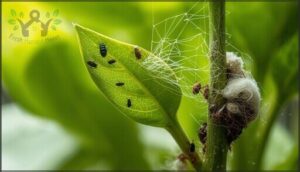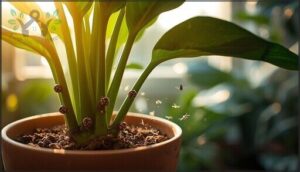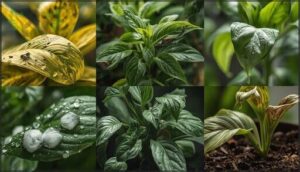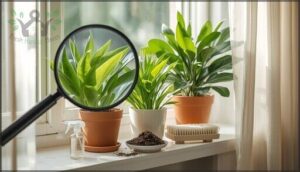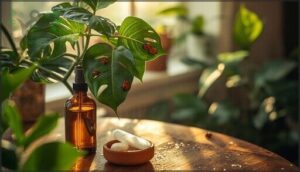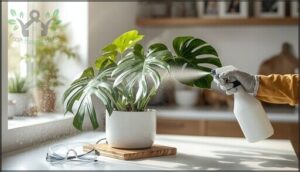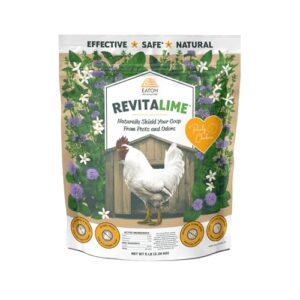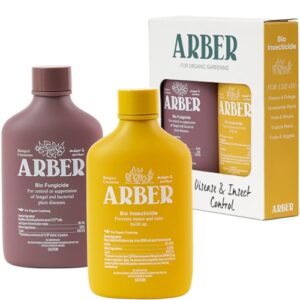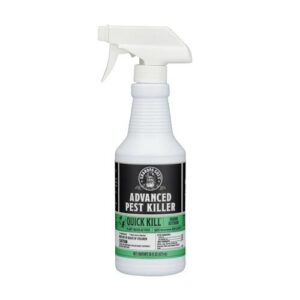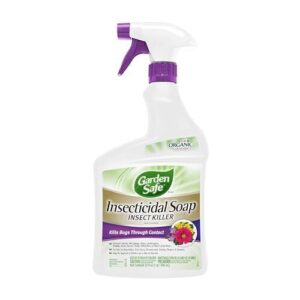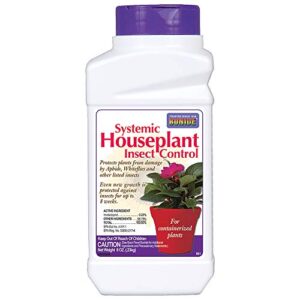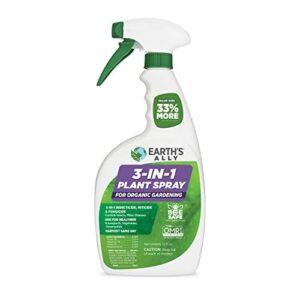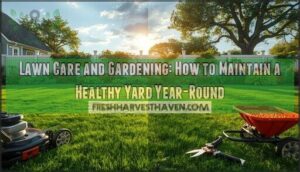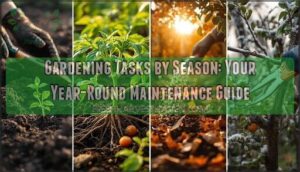This site is supported by our readers. We may earn a commission, at no cost to you, if you purchase through links.
You water your philodendron, check its drainage, even rotate it toward the sunlight—but those yellow-stippled leaves and fine webs between stems tell a different story. Indoor plant pests don’t announce their arrival with fanfare. They slip in unnoticed, multiply in the warmth of your home, and gradually turn thriving greenery into a frustrating puzzle of wilting leaves and sticky residue.
The challenge isn’t just eliminating these unwelcome visitors; it’s catching them early, understanding what you’re dealing with, and choosing pest control for indoor plants that actually works without turning your living room into a chemistry lab.
Whether you’re facing tiny aphids clustered on new growth or mysterious cottony deposits along the stems, effective management starts with recognition, prevention, and knowing which tools—natural or chemical—match your specific situation.
Table Of Contents
- Key Takeaways
- Common Indoor Plant Pests and Symptoms
- Preventing Pest Infestations in Indoor Plants
- Natural and Safe Pest Control Methods
- Chemical Pest Control: Use and Safety Tips
- Top 9 Products for Indoor Plant Pest Control
- 1. Eaton Coop Care Coop Freshener
- 2. Arber Organic Insecticide and Fungicide
- 3. Grandpa Gus’s Natural Pest Control
- 4. Garden Safe Insecticidal Soap Spray
- 5. Bonide Systemic Houseplant Insect Control
- 6. Earth’s Ally 3 in 1 Plant Spray
- 7. Mighty Mint Insect Repellent Spray
- 8. Peppermint Oil Spider Repellent Indoor
- 9. Centipede Away Natural Repellent Balls
- Frequently Asked Questions (FAQs)
- Can pests spread between indoor and outdoor plants?
- How do I dispose of heavily infested plants?
- Are pesticides safe for homes with pets?
- What causes sudden pest outbreaks in winter months?
- Can I reuse soil from pest-infested plants?
- How often should I inspect my plants for pests?
- Can I use outdoor pesticides on indoor plants?
- What causes sudden pest infestations in healthy plants?
- Are coffee grounds effective for repelling plant pests?
- How long does it take plants to recover?
- Conclusion
Key Takeaways
- You’ll stop most infestations before they start by quarantining new plants for two to three weeks, checking them every few days, and maintaining proper care (watering, humidity (40–60%), and air circulation) to keep your collection stress-free and resistant.
- Early detection matters more than any pest spray—weekly inspections of leaf undersides, stems, and soil catch aphids, spider mites, mealybugs, and fungus gnats while populations are still manageable, turning a potential disaster into a minor cleanup.
- Natural controls like neem oil, insecticidal soap, and beneficial insects handle most indoor pest problems safely, but they work gradually and require repeat applications every 4–7 days, so patience and consistent coverage beat one-time treatments.
- Systemic pesticides like imidacloprid provide up to 8 weeks of protection by moving through plant tissues, but they’re restricted in several states, can’t be used on edibles, and should be your last resort after natural methods fail.
Common Indoor Plant Pests and Symptoms
You can’t win the battle against indoor plant pests if you don’t know what you’re up against. Each pest leaves behind its own calling card, from telltale webbing to sticky residue, and learning to spot these signs early makes all the difference.
Let’s walk through the most common invaders you’ll encounter, what they look like, and the damage they cause.
Identifying Aphids, Spider Mites, and Mealybugs
You’ll spot aphids as tiny, soft-bodied insects—often green, yellow, or brown—clustered on new growth, with a key feature being twin tubes at their rear. Spider mites leave fine webbing and stippled, yellowing leaves. Mealybugs look like cottony clusters on stems and leaf joints, while all three pests produce sticky honeydew that attracts sooty mold.
These pests can reproduce quickly, with up to 15 generations each season.
Recognizing Scale Insects, Fungus Gnats, and Whiteflies
Scale insects appear as immobile, dome-shaped bumps, often brown or tan, along stems and leaf undersides, and they excrete sticky honeydew that damages surfaces below.
Fungus gnats resemble tiny mosquitoes hovering near pots after watering, with larvae feeding in moist soil. Adult fungus gnats are often found near decaying organic matter.
Whiteflies look like miniature white moths on leaf undersides, dispersing in clouds when disturbed, and also produce honeydew.
Signs of Pest Infestations on Leaves, Stems, and Soil
Beyond spotting the pests themselves, you’ll notice telltale signs of infestation throughout your plants. Leaf discoloration—yellowing, stippling, or mottling—often signals spider mites or aphids, while sticky surface residues and dark sooty mold point to sap-feeders.
Structural damage like holes, webbing, or distorted growth reveals active feeding. Check plant stems for bumps or white clusters, and watch for soil changes like persistent moisture or tiny flies indicating fungus gnats.
Preventing Pest Infestations in Indoor Plants
You don’t have to wait until pests show up to take action. A few smart habits can stop infestations before they start, saving you time, money, and the heartache of watching your favorite plants struggle.
A few smart habits can stop infestations before they start, saving you time, money, and heartache
Let’s walk through the key prevention strategies that keep your indoor garden healthy and pest-free.
Inspecting and Quarantining New Plants
Regular plant inspection is your first line of defense—think of it as a health screening before introducing any newcomer to your collection. Quarantining new houseplants for at least two to three weeks gives hidden pests time to reveal themselves. Here’s how to do it right:
- Physical Separation: Keep new arrivals in a separate room, at least 10–15 feet from existing plants.
- Inspection Frequency: Check leaves, stems, and soil every 2–3 days during the first two weeks.
- Preventive Treatments: Apply insecticidal soap or neem oil if your plant tolerates it.
- Record-Keeping: Note the quarantine start date and log any symptoms to track the full isolation period.
If pests appear, extend your quarantine duration until you’ve seen no activity for another full cycle.
Proper Watering, Light, and Humidity Management
Environmental balance acts as your houseplant’s invisible shield. Watering frequency must match light intensity—overwatering in low light fuels fungus gnats, while drought under bright conditions invites spider mites. Maintain humidity levels between 40% and 60% to discourage mite reproduction.
Here’s how environmental stress reduction works:
| Factor | Pest-Prone Conditions | Protective Range |
|---|---|---|
| Watering | Saturated soil, standing water | Let top 2–3 cm dry between waterings |
| Light Intensity | Insufficient winter daylight | Supplement with grow lights as needed |
| Humidity | Below 40% in heated rooms | 40–60% using humidifiers or plant grouping |
Microclimate control—monitoring temperature, humidity, and air circulation together—prevents the stress that weakens plant health and opens the door to infestations. Proper watering paired with adequate light keeps your collection vigorous, making preventative measures far more effective than any spray.
Using Quality Potting Soil and Good Air Circulation
Your potting soil choice sets the foundation for pest prevention. Sterile potting mixes—heat-treated to at least 55°C for ten consecutive days—eliminate soil-borne pests and disease organisms that garden soil harbors. Drainage and aeration matter just as much: well-draining media with perlite or chunky bark reduce fungus gnat larvae by roughly half compared to dense, saturated mixes.
Airflow benefits extend beyond the soil—continuous air circulation dries foliage faster, disrupting the stagnant microclimates where spider mites and powdery mildew thrive. Combined, quality potting soil and good air circulation form your first line of defense, keeping indoor plants vigorous and less vulnerable to infestation.
- Select pasteurized commercial mixes over unprocessed garden soil to start clean
- Assure one-third perlite or coarse material by volume for rapid drainage
- Position fans or open windows to create airflow that lowers humidity and discourages foliar disease
Regular Cleaning and Maintenance Routines
Weekly pest surveillance keeps you one step ahead—small colonies spotted early are far simpler to eliminate than full-blown invasions.
Wipe smooth leaves every two to three weeks with tepid water, removing dust and hidden insects in one pass. Tool disinfection between plants prevents disease spread, while debris removal eliminates hiding places.
Together, these preventative measures boost plant vigor and maintain plant health through regular plant inspections.
Natural and Safe Pest Control Methods
When pests show up on your indoor plants, you don’t need to reach for harsh chemicals right away. Natural pest control methods can tackle most common infestations safely and effectively, protecting both your plants and your household.
Here’s a look at some proven natural approaches, from botanical oils to beneficial insects, that help you manage pests without compromising safety.
Neem Oil and Botanical Oil Sprays
Neem oil and botanical oils like rosemary and peppermint offer a gentler path to pest control, disrupting insect feeding and reproduction without harsh residues. These natural sprays work over time—not instantly—so patience pays off.
- Neem oil targets aphids, mites, and whiteflies by interfering with their growth cycles, reducing populations generation by generation.
- Rosemary oil repels spider mites and whiteflies while sparing beneficial predators like ladybugs.
- Peppermint oil deters soft-bodied pests naturally, fitting seamlessly into IPM strategies.
- Low toxicity means safer use around pets and children when you follow label instructions carefully.
Insecticidal Soap and Homemade Remedies
Insecticidal soap breaks down pest cell membranes on contact, making it your go-to for aphids, mealybugs, and spider mites. Commercial alternatives offer tested safety, while homemade recipes using castile soap (1–2% soap concentration) save money but carry phytotoxicity risks.
Test any DIY spray on a small leaf first, apply every 4–7 days, and rinse foliage afterward to protect sensitive plants.
Biological Controls and Beneficial Insects
Beneficial insects act as your frontline defense, hunting down pests without chemical residue. Integrated Pest Management relies on natural pest control methods that target specific threats while protecting your plants. Consider these biological control options:
- Predatory mites like Phytoseiulus persimilis demolish spider mite colonies, especially in enclosed spaces where escape routes are limited.
- Lady beetles consume thousands of aphids over their lifetime, offering sustained pressure against soft-bodied invaders.
- Encarsia formosa parasitizes whiteflies on greenhouse crops, while nematode control using Steinernema feltiae targets fungus gnat larvae in potting media.
IPM integration demands repeated releases and pest-friendly conditions—temperature, light, and pesticide-free environments—to establish lasting predator populations.
Nonchemical Tactics: Washing, Pruning, and Sticky Traps
When biological controls aren’t enough, low-tech physical interventions often solve indoor plant problems without sprays. These preventive measures, combined with regular monitoring, form the backbone of natural pest control methods that keep indoor plants thriving without chemical residues.
Leaf washing dislodges 70% to 90% of mobile pests like aphids and spider mites in a single pass under lukewarm water, while sanitary pruning removes heavily infested stems before populations explode. Targeted removal using a damp cloth addresses sessile scale and mealybug clusters, and yellow sticky traps intercept adult fungus gnats and whiteflies near the canopy.
| Tactic | Target Pests |
|---|---|
| Leaf Washing | Aphids, spider mites, whiteflies |
| Sanitary Pruning | Scale, mealybugs, localized infestations |
| Sticky Traps | Fungus gnats, whiteflies (adults) |
| Targeted Removal | Scale insects, honeydew residues |
Chemical Pest Control: Use and Safety Tips
Sometimes natural methods aren’t enough, and you’ll need to reach for chemical pesticides to save your indoor plants. When you do, choosing the right product and using it safely becomes essential, especially in spaces where you live, cook, and spend time with loved ones.
Here’s what you need to know about selecting effective pesticides, targeting the right pests, and keeping everyone in your household safe.
Selecting Indoor-Safe Pesticides
Before you purchase any pesticide for houseplants, check the label to confirm it’s approved for indoor use—federal regulations require this designation, since homes have far less ventilation than gardens. Active ingredient safety, ventilation importance, and proper label reading protect your family while you manage pests effectively.
- Choose products explicitly marked for houseplants: Outdoor formulations often contain compounds unsuitable for enclosed spaces, even if they seem similar.
- Prioritize lower-risk options like neem oil and insecticidal soap: These organic pest control choices break down quickly and are safe for pets when used correctly.
- Understand systemic product risks: Granular treatments persist in plant tissues for weeks, extending both protection and potential exposure indoors.
- Increase airflow during application: Open windows and mix insecticidal sprays outdoors to prevent vapor buildup in your living space.
- Plan for safe disposal: Never store unused pesticide containers inside; follow local hazardous waste guidelines to prevent chronic contamination.
Targeting Specific Pests With Systemic or Contact Sprays
Once you’ve chosen a safe product, match it to how your pest feeds. Systemic insecticides move through sap, making them ideal for aphids, whiteflies, and mealybugs—imidacloprid reaches effective concentrations in one to two weeks. Contact coverage with insecticidal sprays works better for spider mites and adult whiteflies on foliage. For fungus gnat larvae in soil, drench with Bacillus thuringiensis or a systemic treatment.
| Pest Type | Best Spray Method | Why It Works |
|---|---|---|
| Aphids, mealybugs, whiteflies | Systemic insecticides (soil drench) | Active ingredient translocates into sap, killing pests as they feed |
| Spider mites, adult whiteflies | Contact sprays (neem oil, insecticidal soap) | Direct coverage kills exposed stages on leaf surfaces |
| Fungus gnat larvae | Soil drench (Bti or systemic) | Targets larvae in top soil layer where they feed on roots |
Rotate pesticides every few applications—continuous use of one active ingredient has produced resistance ratios exceeding twentyfold in aphid populations. Apply systemic drenches early in an infestation, since they need days to reach lethal concentrations throughout plant tissues. Contact sprays require repeat applications every three to seven days to catch newly hatched nymphs.
Supplement systemics with insecticidal soap during heavy outbreaks to control pests while the drench takes full effect, ensuring application timing aligns with pest biology for maximum impact.
Minimizing Risks to Pets, Children, and Edible Plants
After choosing your spray, keep everyone safe. Store pesticides where children can’t reach them, never in food containers. Remove pet dishes and toys before applying anything.
If you’re treating edible plants, opt for low-toxicity selection like insecticidal soap or natural remedies—chemical-free pest control options pose fewer indoor exposure risks. Wait until sprays dry completely before letting kids or pets back near treated areas.
Top 9 Products for Indoor Plant Pest Control
When you’re ready to move beyond prevention and tackle an active infestation, having the right product on hand makes all the difference. The options below range from botanical oils and insecticidal soaps to systemic treatments and natural repellents, each designed to address specific pest problems in your indoor garden.
Here are nine reliable products that can help you restore your plants to health.
1. Eaton Coop Care Coop Freshener
Eaton Coop Care Coop Freshener wasn’t designed for houseplant pests, but its peppermint and thyme blend offers mild repellency against mites and fleas in poultry coops. The 5-pound powder combines calcite, citric acid, and botanical oils to control odor and reduce ammonia buildup while maintaining a dry environment.
Though marketed as plant-safe for gardens and barns, you won’t find validated efficacy data for indoor plants or common houseplant pests like aphids or fungus gnats. Consider it a supplemental environmental deterrent rather than a primary pest control method for your collection.
Best For: Backyard chicken keepers looking for a natural coop freshener that controls odor and offers mild pest deterrence, though not ideal as a primary solution for indoor plant pests.
- Natural formula with calcite, citric acid, peppermint, and thyme that’s safe for chickens, pets, and plants
- Effectively controls ammonia buildup and odor while absorbing moisture to keep coops dry
- Provides some insect repellency against mites and fleas through botanical essential oils
- Expensive at around $28 for 5 lbs with mixed feedback on value for money
- Requires frequent reapplication (1-2 times per week) for ongoing effectiveness
- No validated efficacy data for indoor plant pests like aphids or fungus gnats, limiting use beyond poultry environments
2. Arber Organic Insecticide and Fungicide
Arber’s biological insecticide and fungicide pair microbial actives—Chromobacterium subtsugae and Bacillus amyloliquefaciens—with OMRI organic certification, targeting aphids, spider mites, mealybugs, thrips, powdery mildew, and blights. You’ll mix the concentrate at roughly 1 oz per gallon for most applications.
User outcomes include cleared powdery mildew in two treatments and restored rose blooms within 10 days. The safety profile allows use around pets, children, and pollinators, making these eco-friendly pest control methods practical for indoor collections and edible gardens alike.
Best For: Organic gardeners and indoor plant collectors who want pet-safe, pollinator-friendly control of common pests like aphids and spider mites plus fungal diseases like powdery mildew and blight.
- OMRI-certified microbial formulas work on both insects and fungal diseases without harming bees, butterflies, pets, or kids
- Users report fast results—powdery mildew cleared in two treatments, rose blooms restored in 10 days, and consistent prevention with routine use
- Concentrate format at ~1 oz per gallon makes it economical for larger plant collections and outdoor gardens
- Mixed effectiveness against tougher pests like mealybugs and scale, with some users reporting it didn’t solve their problem
- Price point is higher than conventional options, which some customers found expensive for the bottle size
- Results can vary by pest and plant type, and a few users noted an unpleasant smell during application
3. Grandpa Gus’s Natural Pest Control
Grandpa Gus’s Enhanced Pest Killer delivers plant-based efficacy through cottonseed and clove oils, targeting aphids, mites, and more than 40 household insects on indoor plants.
The product composition includes non-staining, non-greasy sprays with a light scent, making indoor suitability practical for living rooms and kitchens.
The safety profile allows use around children and pets when dried, reflecting low mammalian toxicity.
User performance reports show 5.0 ratings, rapid contact kill, and two-year satisfaction, though periodic reapplication is needed—consistent with natural pest control and pest prevention strategies for indoor plants.
Best For: Indoor plant owners who want a natural alternative to synthetic pesticides for managing soft-bodied pests like aphids and mites without harsh chemical residues.
- Plant-based formula using cottonseed and clove oils works quickly on contact against aphids, mites, and other common indoor plant pests
- Non-staining and non-greasy, so you can spray around pots and furniture without worrying about residue or damage
- Safe for homes with kids and pets once the spray dries, plus the scent is way milder than typical chemical bug sprays
- You’ll need to reapply regularly since natural oils don’t last as long as synthetic insecticides
- Mixed reviews suggest it doesn’t work equally well on all insects—some people found it less effective on flies and harder-shelled bugs
- A few customers reported concerns about toxicity to cats despite the pet-safe labeling, so watch your pets closely after application
4. Garden Safe Insecticidal Soap Spray
Garden Safe Insecticidal Soap Spray uses potassium salts of fatty acids at a 1.0% concentration to disrupt cell membranes of soft-bodied houseplant pests, including aphids, mealybugs, spider mites, and whiteflies.
Application methods require thorough coverage, especially on leaf undersides, with direct contact essential for pest control effectiveness.
Plant safety is high when you follow label directions, though sensitive species may show phytotoxicity with repeated use. The pest spectrum excludes hard-bodied insects, and reapplication is needed every 4–7 days.
This ready-to-use formulation suits organic gardening and indoor plants, allowing harvest-day use on edibles.
Best For: Gardeners looking for a low-toxicity, ready-to-use spray to quickly knock down soft-bodied pests like aphids and mealybugs on vegetables, ornamentals, and houseplants without a harvest waiting period.
- Kills aphids, mealybugs, spider mites, and whiteflies on contact with plant-based fatty acids, and you can use it right up to harvest day on edibles.
- Safe for organic gardening and indoor use when applied as directed, with lower toxicity than synthetic insecticides.
- No mixing required—the ready-to-use trigger spray makes application quick and convenient for small gardens or houseplants.
- Requires direct contact with pests to work and has almost no residual activity, so you’ll need to reapply every 4–7 days until pests are gone.
- Doesn’t control larger or hard-bodied insects like caterpillars or beetles, limiting its usefulness against a full range of garden pests.
- Can cause leaf burn on sensitive plants if overused, and the 32-ounce bottle may run out quickly on larger gardens or heavy infestations.
5. Bonide Systemic Houseplant Insect Control
Systemic insecticides work differently than contact sprays—they move through your plant’s roots and tissues, so pests feeding on leaves or stems ingest the active ingredient. Bonide Systemic Houseplant Insect Control contains 0.22% imidacloprid in ready-to-use granules that you mix into soil, providing up to 8 weeks of protection against aphids, mealybugs, scale, and whiteflies.
However, imidacloprid concerns include restrictions in several states and potential resistance management issues with repeated use. Never apply this to edible plants, and keep pets away during granule application and watering.
Best For: Indoor plant owners dealing with recurring infestations of aphids, mealybugs, scale, or whiteflies who want long-lasting protection without frequent reapplication.
- Provides up to 8 weeks of systemic protection with a single application, reducing the need for weekly spraying
- Easy to use—just sprinkle granules on soil and water in, no mixing or measuring required
- Targets pests that feed on plant tissues, including hard-to-reach insects like scale and mealybugs
- Restricted or banned in several states including California, Connecticut, and Vermont due to neonicotinoid regulations
- Cannot be used on any edible plants such as herbs, vegetables, or fruit-bearing houseplants
- Takes several days to work since the active ingredient must move from roots into leaves before pests ingest it
6. Earth’s Ally 3 in 1 Plant Spray
If you want a botanical oil blend that combats soft-bodied insects and fungal diseases in one go, Earth’s Ally 3 in 1 Plant Spray delivers broad-spectrum control with thyme, rosemary, clove, and peppermint oils.
It’s OMRI Listed for organic gardening use and proven bee safe, making it appropriate for indoor plant pests like aphids, spider mites, and whiteflies.
For application best practices, saturate both leaf surfaces, especially undersides where pests hide. The safety profile review shows it’s suitable around pets and people when used as directed.
Best For: Organic gardeners and houseplant owners who need a multi-purpose spray to tackle soft-bodied pests like aphids and spider mites plus fungal issues like powdery mildew, all while keeping things safe for pets and pollinators.
- Three-in-one formula handles insects, mites, and fungal diseases in a single product, so you don’t need a cabinet full of different treatments.
- OMRI Listed and made with botanical oils (thyme, rosemary, clove, peppermint), which means it fits organic gardening standards and is safe around kids and pets.
- Zero-day harvest interval lets you spray edibles right up to picking time, and it’s been tested as bee safe when used correctly.
- The ready-to-use spray has a pretty low concentration of active ingredients (0.31% total), so stubborn infestations might need repeat applications or won’t clear up at all.
- Some users report hit-or-miss results, and the spray bottle design can make it tricky to thoroughly coat the undersides of leaves where pests love to hang out.
- It’s pricier than synthetic alternatives, and even the concentrate requires frequent reapplication every 7–10 days to stay on top of pest pressure.
7. Mighty Mint Insect Repellent Spray
When you need a natural repellent for spiders, ants, and roaches that won’t harm pets or kids, Mighty Mint Insect Repellent Spray uses 4% peppermint oil to deter pests on baseboards, entryways, and patios.
Application frequency runs every two weeks for best coverage, though scent sensitivity can be a concern—some users find the mint aroma overwhelming.
Safety considerations favor families seeking natural pest control, yet product comparison reveals it works best for prevention rather than active infestations, where stronger formulations may be necessary.
Best For: Families with pets and kids looking for a natural, plant-based way to keep spiders, ants, and roaches away from common entry points without harsh chemicals.
- Safe formula for homes with children and pets when used as directed, giving you peace of mind during routine pest prevention.
- Ready-to-use spray with good coverage—one 16 oz bottle treats up to 5,000 square feet, making it easy to protect baseboards, doorways, and outdoor spaces.
- Leaves a fresh mint scent that doubles as a natural air freshener while deterring common household pests.
- Requires reapplication every two weeks to maintain effectiveness, which can get tedious and costly over time.
- Not strong enough for serious infestations—works best as a preventive measure rather than a solution for active pest problems.
- Strong peppermint aroma may be too intense for people with scent sensitivities or allergies, and in rare cases may not repel pests as expected.
8. Peppermint Oil Spider Repellent Indoor
If spiders have claimed corners near your indoor plants, peppermint oil spider repellent offers a botanical alternative with mixed real-world outcomes. You’ll apply diluted sprays—usually 10 to 20 drops per 16 ounces of water—to baseboards, windowsills, and entry points every two to three weeks as volatile compounds dissipate.
Safety considerations include avoiding direct contact with undiluted oil and ensuring good ventilation, especially around pets.
User-reported outcomes vary by spider species, so integrated pest management pairs peppermint applications with sealing cracks and regular vacuuming for more reliable control.
Best For: Homeowners looking for a pet-safe, natural spider deterrent who are willing to reapply every few weeks and combine it with physical prevention methods like sealing gaps and regular cleaning.
- Safe for use around children and pets when properly diluted, with botanical ingredients that avoid harsh chemical exposure in living spaces.
- Pleasant peppermint scent provides a refreshing aroma while treating baseboards, windowsills, and entry points throughout the home.
- Can be easily integrated into regular cleaning routines by adding drops to spray bottles or placing oil-soaked cotton balls in spider-prone areas.
- Effectiveness varies significantly by spider species, with studies showing only 2 of 3 tested species avoided treated areas, making results unpredictable.
- Requires frequent reapplication every 2–3 weeks as volatile compounds dissipate quickly, leading to ongoing effort and higher long-term costs.
- Limited scientific evidence for consistent spider repellency, with some controlled tests showing no observable reduction in spider activity even with regular applications.
9. Centipede Away Natural Repellent Balls
Centipedes near houseplants often respond better to moisture management than fragrance alone, yet these natural repellent balls combine peppermint, lemongrass, and clove oils—4%, 2%, and 2% product active ingredients respectively—in a calcium carbonate carrier. Essential oil repellency fades faster than synthetic options, requiring frequent replacement.
You’ll place sachets every six to eight inches in problem areas, though centipede control efficacy remains inconsistent without sealing cracks and reducing humidity. User safety concerns center on strong odors that may trigger migraines, so natural pest control here works best as one layer in broader indoor plant pest prevention strategies.
Best For: People dealing with centipede problems in garages, basements, or outdoor storage areas who want a plant-based deterrent and don’t mind a strong peppermint smell or frequent replacement.
- Natural formula with essential oils (peppermint, lemongrass, clove) that’s safer around kids and pets than synthetic pesticides
- Comes in a 24-pack with fabric bags for easy placement in multiple problem spots indoors and outdoors
- Works as part of a broader pest management approach when combined with moisture control and sealing entry points
- Strong, potent smell can be overwhelming and may trigger migraines or asthma in sensitive individuals
- Essential oil repellency fades quickly and requires more frequent replacement than synthetic alternatives
- Inconsistent effectiveness against centipedes without additional measures like reducing humidity and sealing cracks
Frequently Asked Questions (FAQs)
Can pests spread between indoor and outdoor plants?
Yes, pest infestations move both ways. Spider mites, aphids, and fungus gnats colonize plants you bring inside, while heavily infested houseplants become pest reservoirs that spread to your outdoor garden through quarantine failures.
How do I dispose of heavily infested plants?
When plant salvageability looks grim—with pest control failing after repeated attempts—seal the infested plant in heavy plastic bags. This containment method prevents root damage and plant debris from spreading.
Skip compost; choose destruction methods like trash disposal, then sanitize containers before reuse.
Are pesticides safe for homes with pets?
Most chemical pest control products pose significant toxicity risks to dogs and cats. Safe for pets alternatives include neem oil and insecticidal soap, but even natural options demand careful application and strict regulatory compliance.
What causes sudden pest outbreaks in winter months?
Winter’s dry indoor air acts like a welcome mat for pests, weakening defenses while overwatering issues, pest introduction through new plants, and no predators create perfect conditions for rapid infestations indoors.
Can I reuse soil from pest-infested plants?
Reusing risks are high—many pests complete their life cycle in the root zone. Thermal treatment or chemical options can help, but best practices favor discarding infested plant soil and repotting in fresh mix.
How often should I inspect my plants for pests?
Check your plants at least once a week for signs of infestation, looking closely at leaf undersides and stems during watering.
Increase inspection frequency for new or stressed plants and during warmer seasons.
Can I use outdoor pesticides on indoor plants?
No, you shouldn’t use outdoor pesticides on indoor plants. Label restrictions prohibit it, and indoor exposure creates health risks for people and pets while potentially causing plant safety issues through phytotoxicity.
What causes sudden pest infestations in healthy plants?
Sudden pest infestations often stem from new plant introduction, environmental stress factors, overwatering effects, indoor climate shifts, or human/pet vectors.
Preventing pest infestations relies on pest prevention, early detection of pests, and quarantining newcomers before integrating.
Are coffee grounds effective for repelling plant pests?
Despite anecdotal evidence, coffee grounds don’t reliably repel indoor plant pests—they’re more folk remedy than fact.
Studies show caffeine efficacy requires concentrations unused grounds lack, and damp layers may actually encourage fungal growth.
How long does it take plants to recover?
Recovery timeframe varies with pest effects and damage severity. Light infestations show improvement within 7 to 14 days, while moderate cases need 2 to 4 weeks for new growth after treatment impact subsides.
Conclusion
Think of your indoor garden as a fortress: the strongest defense isn’t built after invaders arrive, but through vigilant watch at the gates. Effective pest control for indoor plants depends on catching problems early, maintaining plant vigor through proper care, and choosing targeted interventions—whether botanical oils or systemic treatments—that match the threat.
With consistent inspection routines and swift action when symptoms appear, you’ll keep destructive pests from gaining ground in your green sanctuary.
- https://terrariumtribe.com/houseplant-statistics/
- https://www.greenhousemag.com/article/insect-control-report-2024-envu/
- https://extension.umd.edu/resources/yard-garden/indoor-plants/indoor-plant-insects
- https://allegany.cce.cornell.edu/gardening/pest-management/a-spooky-houseplant-pest-fungus-gnats
- https://ipm.cahnr.uconn.edu/wp-content/uploads/sites/3216/2022/12/2021PestManagementforretailersjanuary20final.pdf


